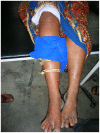Snake bite in South Asia: a review - PubMed (original) (raw)
Review
Snake bite in South Asia: a review
Emilie Alirol et al. PLoS Negl Trop Dis. 2010.
Abstract
Snake bite is one of the most neglected public health issues in poor rural communities living in the tropics. Because of serious misreporting, the true worldwide burden of snake bite is not known. South Asia is the world's most heavily affected region, due to its high population density, widespread agricultural activities, numerous venomous snake species and lack of functional snake bite control programs. Despite increasing knowledge of snake venoms' composition and mode of action, good understanding of clinical features of envenoming and sufficient production of antivenom by Indian manufacturers, snake bite management remains unsatisfactory in this region. Field diagnostic tests for snake species identification do not exist and treatment mainly relies on the administration of antivenoms that do not cover all of the important venomous snakes of the region. Care-givers need better training and supervision, and national guidelines should be fed by evidence-based data generated by well-designed research studies. Poorly informed rural populations often apply inappropriate first-aid measures and vital time is lost before the victim is transported to a treatment centre, where cost of treatment can constitute an additional hurdle. The deficiency of snake bite management in South Asia is multi-causal and requires joint collaborative efforts from researchers, antivenom manufacturers, policy makers, public health authorities and international funders.
Conflict of interest statement
The authors have declared that no competing interests exist.
Figures
Figure 1. Gum bleeding after bite by Russell's viper.
In Asia, coagulation defects and spontaneous bleeding are characteristic of bites by viperid snakes and are caused by procoagulant and haemorrhagic toxins in the snake venom. Image credit: D. A. Warrell.
Figure 2. “Broken neck” sign observed in a 14-year-old girl bitten by a Russell's viper in India.
Envenoming by cobras, kraits and—in some areas—by Russell's viper frequently leads to progressive descending paralysis. Looking for the broken neck sign, which is caused by paralysis of the neck flexor muscles, should be part of the routine clinical assessment of patients. In this case, neuroparalysis persisted for five days despite antivenom treatment, but without progression toward respiratory failure. Image credit: H. S. Bawaskar.
Figure 3. Tourniquet on a 43-year-old woman presenting at a rural health post in Nepal.
First-aid methods applied throughout South Asia are largely inadequate. Tourniquets in particular can have deleterious effects. This patient consulted after being bitten by a nonvenomous rat snake (Ptyas mucosa) that she had killed and brought for identification. After reassurance, local treatment, and observation, she was uneventfully discharged from the health post. Image credit: E. Alirol.
Similar articles
- The impact of snake bite on household economy in Bangladesh.
Hasan SM, Basher A, Molla AA, Sultana NK, Faiz MA. Hasan SM, et al. Trop Doct. 2012 Jan;42(1):41-3. doi: 10.1258/td.2011.110137. Epub 2012 Jan 5. Trop Doct. 2012. PMID: 22223726 - Vulnerability to snakebite envenoming: a global mapping of hotspots.
Longbottom J, Shearer FM, Devine M, Alcoba G, Chappuis F, Weiss DJ, Ray SE, Ray N, Warrell DA, Ruiz de Castañeda R, Williams DJ, Hay SI, Pigott DM. Longbottom J, et al. Lancet. 2018 Aug 25;392(10148):673-684. doi: 10.1016/S0140-6736(18)31224-8. Epub 2018 Jul 17. Lancet. 2018. PMID: 30017551 Free PMC article. - Antivenom for snakebite envenoming in Sri Lanka: the need for geographically specific antivenom and improved efficacy.
Keyler DE, Gawarammana I, Gutiérrez JM, Sellahewa KH, McWhorter K, Malleappah R. Keyler DE, et al. Toxicon. 2013 Jul;69:90-7. doi: 10.1016/j.toxicon.2013.01.022. Epub 2013 Feb 20. Toxicon. 2013. PMID: 23454626 - Snake bite.
Warrell DA. Warrell DA. Lancet. 2010 Jan 2;375(9708):77-88. doi: 10.1016/S0140-6736(09)61754-2. Lancet. 2010. PMID: 20109866 Review. - The concept of Big Four: Road map from snakebite epidemiology to antivenom efficacy.
Gopal G, Muralidar S, Prakash D, Kamalakkannan A, Indhuprakash ST, Thirumalai D, Ambi SV. Gopal G, et al. Int J Biol Macromol. 2023 Jul 1;242(Pt 1):124771. doi: 10.1016/j.ijbiomac.2023.124771. Epub 2023 May 9. Int J Biol Macromol. 2023. PMID: 37169043 Review.
Cited by
- Snakebite in the Hills and Mountains of Nepal.
Bogati S, Bhatt N, Nepal S, Nepali P, Sharma SK. Bogati S, et al. JNMA J Nepal Med Assoc. 2022 Dec 1;60(256):1066-1069. doi: 10.31729/jnma.7562. JNMA J Nepal Med Assoc. 2022. PMID: 36705115 Free PMC article. - Knowledge of first aid methods and attitude about snake bite among medical students: a cross sectional observational study.
Subedi N, Paudel IS, Khadka A, Shrestha U, Mallik VB, Ankur KC. Subedi N, et al. J Occup Med Toxicol. 2018 Aug 15;13:26. doi: 10.1186/s12995-018-0210-0. eCollection 2018. J Occup Med Toxicol. 2018. PMID: 30147746 Free PMC article. - Venom proteomics and antivenom neutralization for the Chinese eastern Russell's viper, Daboia siamensis from Guangxi and Taiwan.
Tan KY, Tan NH, Tan CH. Tan KY, et al. Sci Rep. 2018 Jun 4;8(1):8545. doi: 10.1038/s41598-018-25955-y. Sci Rep. 2018. PMID: 29867131 Free PMC article. - Neurotoxin envenomation mimicking brain death in a child: A case report and review of literature.
Dayal M, Prakash S, Verma PK, Pawar M. Dayal M, et al. Indian J Anaesth. 2014 Jul;58(4):458-60. doi: 10.4103/0019-5049.139008. Indian J Anaesth. 2014. PMID: 25197117 Free PMC article. - Snake Antivenoms-Toward Better Understanding of the Administration Route.
Gamulin E, Mateljak Lukačević S, Halassy B, Kurtović T. Gamulin E, et al. Toxins (Basel). 2023 Jun 15;15(6):398. doi: 10.3390/toxins15060398. Toxins (Basel). 2023. PMID: 37368699 Free PMC article. Review.
References
- Simpson ID, Norris RL. The global snakebite crisis–a public health issue misunderstood, not neglected. Wilderness Environ Med. 2009;20:43–56. - PubMed
- Ali Z. Snake bite: a medical and public health problem in Pakistan. In: Gopalakrishnakone P, Chou LM, editors. Snakes of medical importance (Asia Pacific region) Singapore. National University Singapore; 1990. pp. 447–461.
Publication types
MeSH terms
Substances
LinkOut - more resources
Full Text Sources
Other Literature Sources


